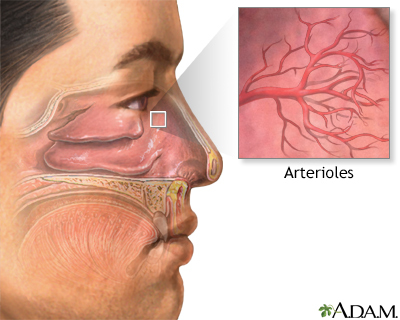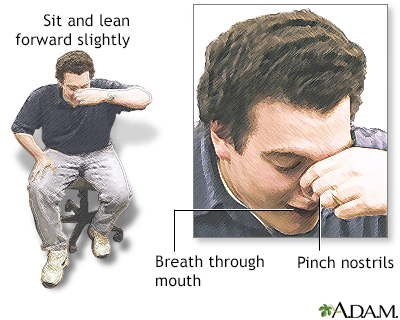Definition
A nosebleed is loss of blood from the tissue lining the nose. Bleeding most often occurs in one nostril only.
Alternative Names
Bleeding from the nose; Epistaxis
Considerations
Nosebleeds are very common. Most nosebleeds occur because of minor irritations or colds.
The nose contains many small blood vessels that bleed easily. Air moving through the nose can dry and irritate the membranes lining the inside of the nose. Crusts can form that bleed when irritated. Nosebleeds occur more often in the winter, when cold viruses are common and indoor air tends to be drier.
Most nosebleeds occur on the front of the nasal septum. This is the piece of the tissue that separates the two sides of the nose. This type of nosebleed can be easy for a trained professional to stop. Less commonly, nosebleeds may occur higher on the septum or deeper in the nose such as in the sinuses or the base of the skull. Such nosebleeds may be harder to control. However, nosebleeds are rarely life threatening.
Causes
Nosebleed can be caused by:
- Irritation due to allergies, colds, sneezing or sinus problems
- Very cold or dry air
- Blowing the nose very hard, or picking the nose
- Injury to nose, including a broken nose, or an object stuck in the nose
- Sinus or pituitary surgery (transsphenoidal)
- Deviated septum (tissue that divides the nose into 2 nostrils)
- Chemical irritants including medicines or drugs that are sprayed or snorted
- Overuse of decongestant nasal sprays
- Oxygen treatment through nasal cannulas
- Snorting cocaine
Repeated nosebleeds may be a symptom of another disease such as high blood pressure, a bleeding disorder, or a tumor of the nose or sinuses. Blood thinners, such as warfarin (Coumadin), clopidogrel (Plavix), or aspirin, may cause or worsen nosebleeds.
Home Care
To stop a nosebleed:
- Sit down and gently squeeze the soft portion of the nose between your thumb and finger (so that the nostrils are closed) for a full 10 minutes.
- Lean forward to avoid swallowing the blood and breathe through your mouth.
- Wait at least 10 minutes before checking if the bleeding has stopped. Be sure to allow enough time for the bleeding to stop.
It may help to apply cold compresses or ice across the bridge of the nose. Do not pack the inside of the nose with gauze.
Lying down with a nosebleed is not recommended. You should avoid sniffing or blowing your nose for several hours after a nosebleed. If bleeding persists, a nasal spray decongestant (Afrin, Neo-Synephrine) can sometimes be used to close off small vessels and control bleeding.
Things you can do to prevent frequent nosebleeds include:
- Keep the home cool and use a vaporizer to add moisture to the inside air.
- Use nasal saline spray and water-soluble jelly (such as Ayr gel) to prevent nasal linings from drying out in the winter.
When to Contact a Medical Professional
Get emergency care if:
- Bleeding does not stop after 20 minutes.
- Nose bleeding occurs after a head injury. This may suggest a skull fracture, and x-rays or other imaging should be taken.
- Your nose may be broken (for example, it looks crooked after a hit to the nose or other injury).
- You are taking medicines to prevent your blood from clotting (blood thinners).
- You have had nosebleeds in the past that needed specialist care to treat.
Contact your health care provider if:
- You or your child has frequent nosebleeds
- Nosebleeds are not associated with a cold or other minor irritation
- Nosebleeds occur after sinus or other surgery
What to Expect at Your Office Visit
The provider will perform a physical exam. In some cases, you may be watched for signs and symptoms of low blood pressure from losing blood, also called hypovolemic shock (this is rare).
You may have the following tests:
- Complete blood count
- CT scan of the nose and sinuses or entire facial structures
- Nasal endoscopy (examination of the nose using a camera at the end of a short tube)
- Partial thromboplastin time measurements
- Prothrombin time (PT)
- Toxicology screen (screening for drug abuse)
The type of treatment used will be based on the cause of the nosebleed. Treatment may include:
- Controlling blood pressure
- Closing the blood vessel using heat, electric current, or silver nitrate sticks
- Nasal packing
- Reducing a broken nose or removing a foreign body
- Reducing the amount of blood thinner medicine or stopping aspirin
- Treating problems that keeps your blood from clotting normally
You may need to see an ear, nose, and throat (ENT, otolaryngologist) specialist for further tests and treatment.
References
Kuan EC, Palmer JN. Epistaxis. In: Flint PW, Francis HW, Haughey BH, et al, eds. Cummings Otolaryngology: Head and Neck Surgery. 7th ed. Philadelphia, PA: Elsevier; 2021:chap 47.
Pfaff JA, Moore GP. Otolaryngology. In: Walls RM, Hockberger RS, Gausche-Hill M, eds. Rosen's Emergency Medicine: Concepts and Clinical Practice. 9th ed. Philadelphia, PA: Elsevier; 2018:chap 62.
Savage S. Management of epistaxis. In: Fowler GC, ed. Pfenninger and Fowler's Procedures for Primary Care. 4th ed. Philadelphia, PA: Elsevier; 2020:chap 205.



